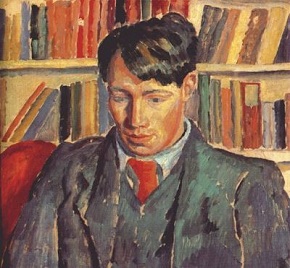De Britse schrijver David (Bunny) Garnett werd geboren in Brighton op 9 maart 1892. Als kind droeg hij een mantel van konijnenbont en daaraan dankte hij de bijnaam Bunny, die zijn familie en vrienden de rest van zijn leven zouden gebruiken, Garnett was de zoon van de schrijver Edward Garnett en Constance Black, een vertaalster van met name Russische literatuur. Hij weigerde tijdens de Eerste Wereldoorlog dienst op grond van gewetensbezwaren en bracht de oorlogsjaren door op een boerderij in Suffolk, Sussex, waar hij de kunstschilder Duncan Grant leerde kennen. Grant was een van de leden van de Bloomsburygroep. Literaire erkenning kreeg Garnett met de verschijning van zijn roman “Lady into Fox” (1922). Hij begon een boekhandel nabij het British Museum en een eigen uitgeverij: de Nonesuch Press. Zijn roman “Aspects of Love” (1955) werd later door Andrew Lloyd Webber tot een musical verwerkt. Zijn eerste vrouw was Rachel Marchall (een zuster van Frances Partridge). Met haar kreeg hij twee zonen, Richard en William. Zijn vrouw overleed evenwel op jonge leeftijd aan de gevolgen van borstkanker. Garnett had ook seksuele relaties met Duncan Grant en Francis Birrell. Hij was op Charleston Farmhouse aanwezig bij de geboorte van Angelica Bell, de dochter van Vanessa Bell en Duncan Grant en voorspelde toen dat hij later met haar zou trouwen. Tot afschuw van haar ouders, gebeurde dat inderdaad in 1942 (de bruidegom toen net 50, de bruid 23). Zij kregen samen vier dochters (Amaryllis, Henriette en de tweeling Nerissa en Frances). De oudste dochter Amaryllis Garnett werd actrice. Angelica en Bunny scheidden in 1961 en daarna leefde Garnett in Frankrijk, waar hij uiteindelijk ook overleed.
Uit: Lady into Fox
„Wonderful or supernatural events are not so uncommon, rather they are irregular in their incidence. Thus there may be not one marvel to speak of in a century, and then often enough comes a plentiful crop of them; monsters of all sorts swarm suddenly upon the earth, comets blaze in the sky, eclipses frighten nature, meteors fall in rain, while mermaids and sirens beguile, and sea-serpents engulf every passing ship, and terrible cataclysms beset humanity.
But the stra nge event which I shall here relate came alone, unsupported, without companions into a hostile world, and for that very reason claimed little of the general attention of mankind. For the sudde n changing of Mrs. Tebrick into a vixen is an established fact which we may attempt to account for as we will. Certainly it is in the explanation of the fact, and the reconciling of it with our generalnotions that we shall find most difficulty, and not in accepting for true a story which is so fully proved, and that not by one witness but by a dozen, all respectable, and with no possibility of collusionbetween them.
But here I will confine myself t o an exact narrative of the event and all that followed on it. Yet I would not dissuade any of my readers from attempting an explanation of this seeming miracle because up till now none has been found which is entirely satisfactory. What adds to the difficulty to my mind is that the metamorphosis occurred when Mrs. Tebrick was a full-grown woman, and that it happened suddenly in so short a space of time. The sprouting of a tail, the gradual extension of hair all over the body, the slow change of the whole anatomy by a process of growth, though it would have been monstrous, would not have been so difficult to reconcile to our ordinary conceptions, particularlyhad it happened in a young child.
But here we have something very different. A grown lady is changed straightway into a fox. There is no explaining that away by any natural philosophy. The materialism of our age will not help us here. It is indeed a miracle; something from outside our world altogether; an event which we would willingly accept if we were to meet it invested with the authority of Divine Revelation in the scriptures, but which we are not prepared to encounter almost in our time, happening in Oxfordshire amongst our neighbours.“

David Garnett (9 maart 1892 – 17 februari 1981)
Portret door Duncan Grant, ca. 1920
